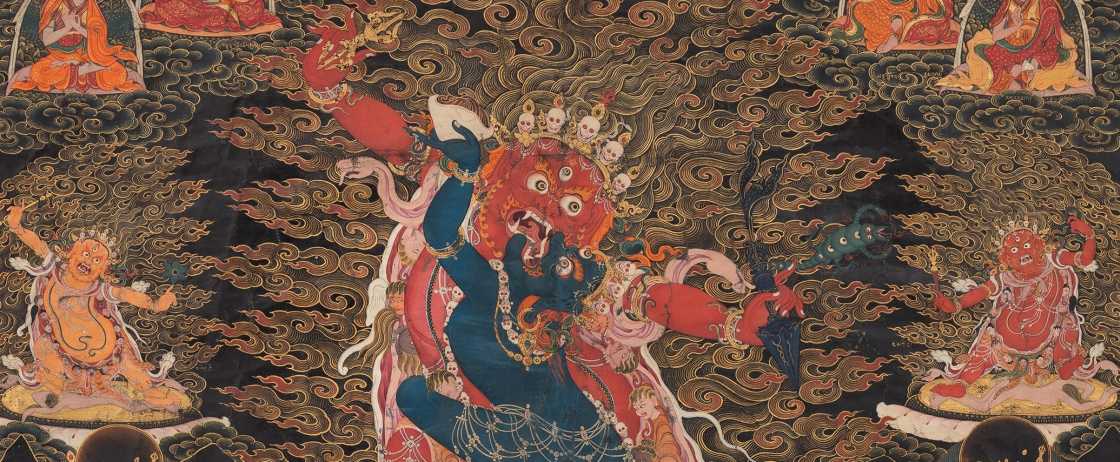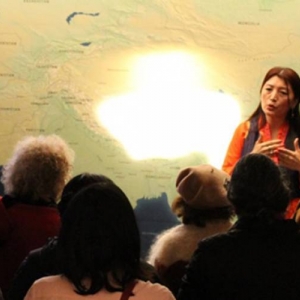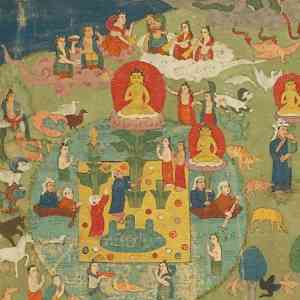
Stories and Treasure Teachings of Padmasambhava
Himalayan Heritage Talk and Tour
Wednesday, 11.7.18
6:30 PM - 8:00 PM
For Tibetans in exile, stories are a gateway to connecting to a Tibet that is more than just a geographic region, but also a spiritual and historical legacy. Tenzing Wangdak, an ethnographic researcher at New York University, will share his visualization of this spiritual realm rooted in the stories of elder Tibetans.
The storytelling will be followed by a treasure map tour of the galleries created by Tom Campbell, a former monk in the Vajrayana tradition, a cultural anthropologist, and attorney. We will closely look at art that reveals the watershed treasure-teachings of Padmasambhava, who is often referred to as the Second Buddha in Tibet. The teachings include a ritual to empower community, a Tantric visualization of the wrathful, purifying deity Vajrakilaya, and a teaching to cultivate highest insight awareness. Each teaching offers symbols and stories that can help us cut through our own obstacles and cultivate compassion.
The program will be introduced by Tashi Chodron, assistant manager of himalayan cultural programs and partnerships, and takes place on the 6th floor in the exhibition The Second Buddha: Master of Time.
About the Speakers
Tom Campbell, a cultural anthropologist and attorney, who teaches Indo-Tibetan Literature at McGill University in Montreal. He spent many years as a monk in the Vajrayana tradition (in Geneva, Switzerland; Moscow, Russia; and Ulaanbaatar, Mongolia), and also in the Zen tradition (in Los Angles). He teaches workshops on meditation methods in mindfulness, Zen, and Vajrayana paths.
His current project is teaching interdisciplinary clinical art therapy at Laval University, Quebec City, an experimental program integrating studies in psychology, Buddha-dharma, and studio art. His Law Practice specializes in international arbitration.
Tenzing Wangdak is a first-generation Tibetan born in exile. Tenzing grew up in a very non-Tibetan environment, and only during the last two years of his high school did he re-enter his community through his education in a Tibetan school. Later he spent five years of his adult life in Indian universities as well as a year in between in a Buddhist Dialectic Institute. Having lived in these different environments, he has always questioned his identity as a Tibetan, what it means to be one, and more importantly his connection to Tibet, a region so intricately connected to his being yet one that he has never set foot in, always having had to imagine it through the stories of his elders and other secondary sources. Currently he is a graduate student at New York University, and primarily involved with an Oral History / Ethnographic research project that looks into the Tibetan diaspora within the New York, Boston, and DC region. The focus of his research, which involves in-depth interviews and has been directed by his own personal experiences as a Tibetan living in diaspora, is to see the different narratives of exile that are being expressed within a generational framework as well as looking into the new ways of engagement with different visions of Tibet, whether it be through personal communication or facilitated by technological advances such as social media. Out of this, he attempts to figure out how these narratives challenge the dominant discourses on Tibet and asks what a return to Tibet means for Tibetans in exile.




